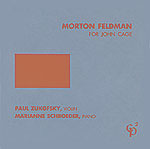
FOR JOHN CAGE
PAUL ZUKOFSKY, violin
MARIANNE SCHROEDER, piano

 |
MORTON FELDMAN FOR JOHN CAGE PAUL ZUKOFSKY, violin MARIANNE SCHROEDER, piano |
 |
The original of the following was written ca. 1986, with the intention of being used as a liner note. Prior to Feldman's death in September of 1987 (which I consider a major loss to music in general), I read it to him and he seemed pleased. As the "letter" still represents my views I decided, other than for the last sentence, not to update it. Dear Morty: I thought you wouldn't want to write a liner, so I wrote the following which we'll use for the liner of for John Cage. We've come a long way from those few minutes of Vertical Thoughts II1. Of course, anyone looking at your early versus late pieces would have two immediate questions:
The first of these questions I can answer much more readily than the second. As I once said to your Buffalo(ed) composition class, there is no difference in the intention, therefore the difference in the notation is only yet another instance of Busoni's statement "What the composer's inspiration necessarily loses through notation, his interpreter should restore by his own." Unfortunately, each notation gives rise to a different performance dis-ease. The earlier dis-ease was lack of temporal tension on the part of the performer, lack of the ability to span time (isn't it lovely that the German word for tension -spannung- includes span?). A plop here, a plick there, all fairly without inevitability. The new dis-ease is barline syndrome-i.e. the yoke of the Tsars pounded down each down-beat, with far too few cases of Lully's gangrene! The early disease caused death by lack of impetus, reaction, or response. The new one achieves the same effect through suffocation, a vacuity without fluidity or motion. The first fails as the towers of a cableless suspension bridge fail-meaningless supports in space. The second fails because it is assumed by the player that every pillar (downbeat) is structural, and as a result the building sits, without air, without light, without soaring. Why am I talking about architecture? Primarily because to me your music is the most architectural since Bruckner's, and like Bruckner, evolves slowly over time. Of course you were always accused of being minimalist -first (before minimalism) because there was so little and such quiet activity, and now because it is easy and kitschy to mention your name with those of others. Yet to do so totally misses the mark because you are at the same time concerned with both smaller and larger things. On the small scale, if they are concerned with cells and cellular processes, you are interested in bonding and molecular structures. You have not only put a microscope to time (as they have); you have used that opportunity to put a microscope to intonation and timbre. On the large scale, if they build good, usable, sometimes (very) attractive (and necessary) commercial space, you build houses for people to live in, or cathedrals (i.e., one of God's houses-I wonder-do they allow Jewish architects to build cathedrals?). But there is still the problem of how you got from the very short to the very long. It's all very well to say that the world doesn't need another 20 minutes piece (John recently told me that he is the composer of the 30 minute piece) but how does one develop the sense of what should be beyond that 20 minutes? How did you scale up? I think that the answer may lie in your interest in the visual. Everyone knows that painting influenced your early work-was inseparable from it. Now you are influenced by RUGS-handmade nomadic rugs. If that now is as influential as painting was for the early works, how could this be discussed? I can tell you that when playing your recent music I feel very close to those rug-makers working away — first the border, the same stitch so many times, now a different strand, fewer times, now we start a pattern, it's finished, a background, etc. Certainly the feeling is very different from that of other music, where I walk from room to room, each one with certain proportions, order, and progression. Also — the rug-making explanation helps account for the tiny variations you play within timing and intonation — the equivalent of the irregularities in a hand-sewn rug. Anyway, because of this difference in how the music appears to be structured, I usually give a very short speech before starting this piece, saying that it is approximately 75 minutes long, very quiet, calm; it will take as long as it is going to take; relax, let it happen, and if you can't put up with that idea, leave now. And almost no-one leaves. Someday someone ought to do a study of the art that has influenced you, and find the reflections that exist in your music (a Ph.D. thesis, doubtless). Also, I'd be curious to have someone analyze temporal structure in your music, from the early to the recent music, and plot the whole on D'Arcy Thompson-Julian Huxley relative growth-transformation grids2 (another Ph.D. bites the dust). I don't know if it would show much, but again, it might, and it would be interesting to have a feel for how your structures grew biologically. This piece is a 70th birthday present for John, so we should end with a story-an homage to John's stories. What shall it be? I know-do you remember the time I came to Buffalo to do a concert of John's Six Melodies (just intonation), his solo violin version of Cheap Imitation (Pythagorean intonation)3, and your Spring of Chosroes (mean tone)4, and the music critic (an ex-student of yours no less!) wrote that he didn't understand why I had such a good reputation since I had such a great deal of trouble with my intonation (this after having come back stage to look at the music, and failing to understand the pitch notation)? Now-I'd say this is a very well packaged paragraph. I've just managed to acknowledge John, tell a cute story, advertise two discs, impugn you, pay back the critic, pat myself on the back, and imply that my intonation on this record is intentional! Not bad. I'm sorry I'll never get to see or play 100 precious things5, and I miss you. much love always, PZ 07/07/90 (rev.)
Eight equi-spaced index points are provided for the convenience of the listener.
For John Cage was recorded April 7, 1984 at SONOGRAPHIC AG, Schlieren, Switzerland. Recording Engineer: W.A. Wettler; Montage: Elite Recordings, NYC; Publisher: Universal Edition, Ltd., London. 1 C.F. Peters Corp.--the first work of Feldman's that I recorded.
|